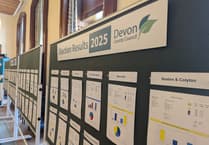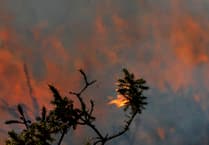Last Saturday myself and my partner Bev went to see a performance of Dabka dancing at St John’s in Totnes organised by Totnes Friends of Palestine. I was especially interested to see the performance as I had worked as a presenter on a pirate radio station based on a ship called the Voice of Peace. It broadcast to the Middle East between 1973 and 1993 with the aim of promoting harmony between Israelis and Palestinians. I had also visited Bethlehem twice before.
The performance was called The Camp’s Gate and the dancers were all from the Alrowwad Cultural and Arts Centre based at the Aida refugee camp in Bethlehem.
It was the final performance in their UK tour.
Alongside the dancing the founder and director of the centre Abdelfattah Abusrour delivered a monologue looking back at the life of his father who had been born in a village destroyed by the Israelis in 1948 and also his own life living under occupation leading to his founding of the centre.
Abdelfattah won a scholarship to study in France but it took numerous attempts to get a permit from the Israelis to travel.
Abdelfattah explained: The centre is a beautiful resistance against the ugliness of Israeli occupation and its violence.
‘We’re here to promote life and inspire hope through performing, visual arts, theatre, dance, photography and video.”
He told a sad story about a little girl called Hayat whose name means 'life' in Arabic who said she wanted to die as she could see no future for herself.
Abdelfattah said there were others like her.
The Aida Camp was first opened in 1950 and at that time consisted of tents. Around 1957 the United Nations Relief and Work Agency replaced the tents with shelters which were small rooms of nine square metres each.
I asked Abdelfattah what he would like to see happen in the future: “The question is even if it is a two-state or thirty-state solution, is it respectful of human rights and values or not?
‘Everybody wants to live with dignity as equal citizens. Palestine was, is and will continue to be a land of multiplicity and diversity.
‘In the streets of the Old City in Jerusalem there is an Armenian Quarter, there is a Christian Quarter, a Muslim Quarter and so on. Of the Israeli claim of a ‘promised land’ he said: "I don’t believe that God is a real estate agent.’’
“The only way people can live together is as equals with respect of justice and equality for the citizens regardless of their colour and religion.
‘We have the oldest Israelite community in the world, the Samaritan community in Nablus who present themselves as Israelites and as Palestinians but not as Jews because Judaism was not born at that time.”
Abdelfatta explained that the Israeli wall runs along the east and north of the camp, three metres deep in the ground, eight metres tall, with eight towers with snipers and surveillance cameras.

In 2017 it was classified as the zone the most exposed to tear gas in the world. He said: “It makes me feel frustrated and angry because the injustice is so visible and people want us to make compromises, forget and move on as if we can move on anywhere without being looked at as terrorists, a potential danger for humankind and so on.”
“It is them (the children) who grow up thinking that it is normal to have this wall, that it is normal to have a checkpoint, that it is normal not to be able to go to Jerusalem which is nine kilometres from Aida refugee camp and if they want to return, whether Muslim or Christian, it is up to the Israelis whether they get a permit or not.” “Even when we toured in France, in the United States there were Zionist groups writing to every place not to allow us to perform because we are terrorists by nature. “If these children are not allowed to dance, not allowed to do theatre, not allowed to present their films, not allowed to tell their stories, what do the Israelis want us to do? Go and explode ourselves?
“This is what they want, make more terrorists and more people who die for whatever cause they are defending?
“We want our children to live. We want them to grow up and change the world and create miracles and be proud of what we achieve together and when the time comes they should be walking in our funerals and not the other way round.
“No parents in the world want to live in the day they bury their children. That’s why we live every opportunity to live, to grow, to change the world and to be proud of the heritage we leave for them and be proud of the change they make they make themselves for their community and the world.
There were six young dancers. Four of them were aged 19 and the other two were 17.
Dancer Shaymaa Darwish is studying to be a simultaneous translator at Hebron University She had seen the sea for the first time in her life here in Devon. It had been impossible for her to visit Gaza and even less Jaffa or Haifa. Even Jericho on the Dead Sea is very difficult to visit.
She said Dabka is: “A traditional dance in Palestine and presenting the Palestinian case.
“It became a part of my life. “I have been dancing dabka since 2013. “It needs lots of practice. I have been training three times a week.”
“We dance to a mixture of old and new Palestinian songs.”
Abdelfattah added: “Palestinian folklore dance goes back to the time of the Caananites (in the Late Bronze Age 1550 to 1200BCE).
“They used to hit the ground to separate the grains from the straw after the harvest.
“They gathered round the fire to ask the plants to grow and the rain to fall.
“Originally there was one guy with a flute and another playing a darbuka (drum) to keep the rhythm and mostly men dancing.
“The Palestinians eventually created their own choreography and women began to join in with the dancing.
“Lebanese and Syrian dancers shake their shoulders more and we don’t have belly dancing like the Egyptions.
“Our dancing is more reserved.”
The evening consisted of the monologue and dancing, a raffle, a question and answer section with Abdelfattah. It finished with an opportunity to have a go at dabka dancing and there was also a stall selling Palestinian goods such as olive soap and keffiyeh scarves.


